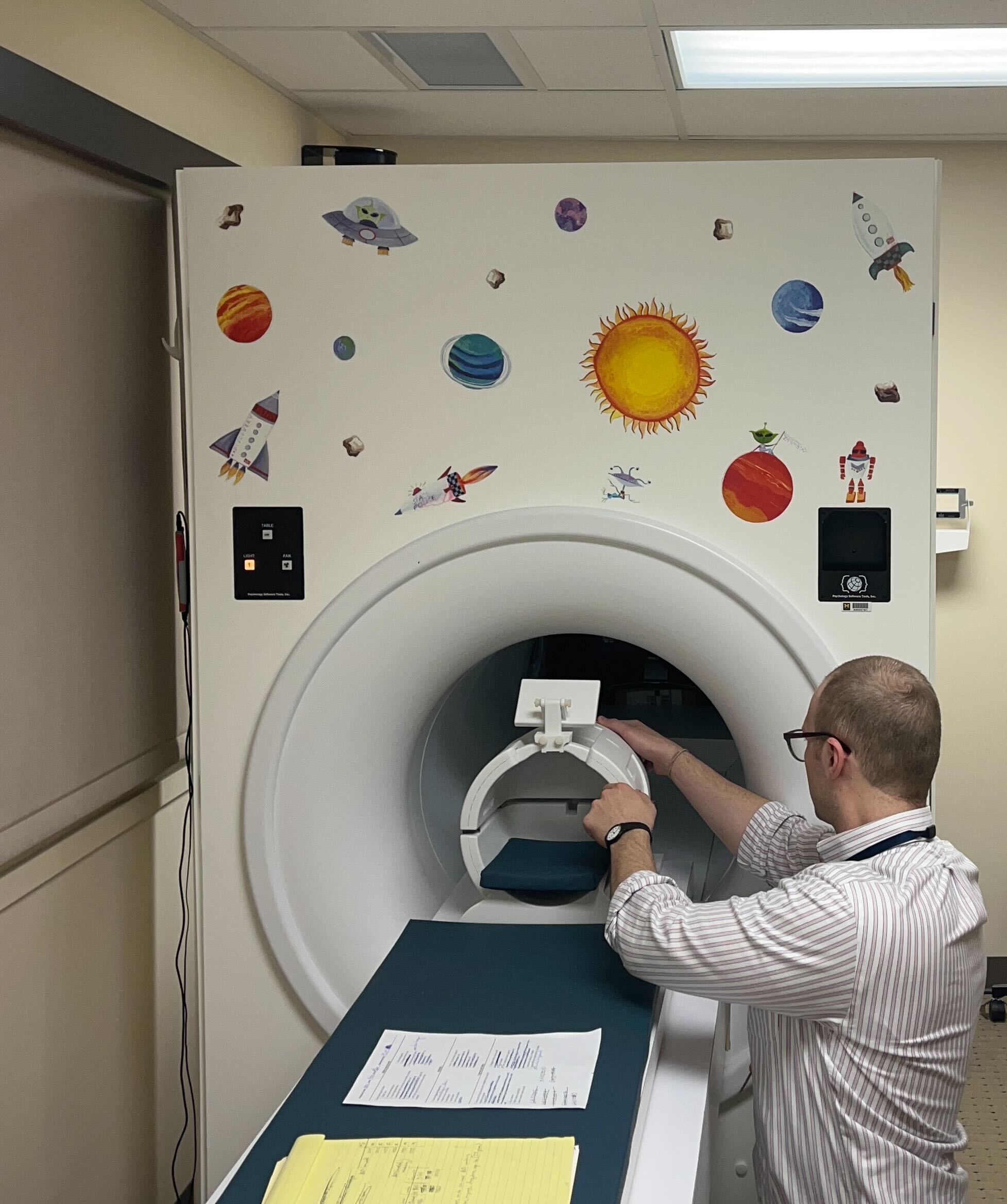
Across the organization, thousands of employees spend their days carrying out exceptional patient care, education and research.
But each individual’s role is unique — and with that in mind, A Day in the Life introduces an employee and gives readers a snapshot of their daily life at Michigan Medicine.
In honor of Better Hearing and Speech Month, meet Nick Mularoni, research assistant in the Speech Neurophysiology Lab in the Department of Psychiatry. The lab’s mission is to research the causes of stuttering and why it persists in some people, paving the way for new stuttering treatments in the future.
Nick supports the lab’s research by working directly with study participants, many of whom are recruited from the communities around Ann Arbor, and guiding them through every step of the process.
8 a.m.: Nick arrives at the Rachel Upjohn Building. After getting settled into his office with a cup of hot black tea, he prepares materials for the study participants who will be coming in. Today, he will work with two child participants, one who stutters and one who doesn’t. He heads downstairs to prepare equipment before his first participant arrives.

“We include both people who stutter and people who don’t, or ‘control participants,’ in our studies so we can compare how they perform in the experiments,” Nick said. “This helps us understand differences and similarities between the groups.”
8:30 a.m.: After checking that all the necessary equipment is ready, Nick steps out to find his first participant, the ”control participant,” has arrived. They are participating in the lab’s EEG — or electroencephalography — study. He helps the child and their family feel welcome in the lab’s research space.
Next, along with the help of another research assistant, he places the EEG cap on the child. It will allow Nick to collect data while the child completes study tasks. A lot goes into the process of fitting the cap: Nick takes several measurements of the child’s head, selects the appropriately-sized cap, and attaches more than 60 delicate electrodes. These will record tiny electrical signals generated by the brain, through the electrodes that are placed on the child’s scalp. Once the cap is on snugly, Nick adds conductive gel to allow the brain waves to travel from the scalp to the electrodes. When the gel does its job, the electrodes light up. The process takes a half hour, and Nick presents it like a game with the child helping to light up all the nodes on the cap in a cheerful green color.

9 a.m.: With the cap in place, Nick guides the child through a series of activities. One activity simply records the brain waves while the child is at rest, and the others include listening and speaking tasks designed to engage certain areas of the brain. Once they’ve completed the study activities, Nick helps the child pick out colorful stickers to take home and then escorts the family out of the lab.
11 a.m.: Nick heads upstairs to meet with his colleagues for their weekly meeting. Today, they’re discussing strategies to increase recruitment for their child and adult studies, such as advertising in regional magazines and parenting websites. Because stuttering occurs in a relatively small percentage of the general population, it’s important they develop new ideas for recruiting broadly beyond the Michigan Medicine community. They’re also reviewing recent data they’ve collected and finalizing the details of a research presentation the team will give at an upcoming conference.
Noon: Nick grabs his lunch and joins colleagues Sherry Chen, Rachel Lycans and Alan Kay in the outside courtyard. It’s a surprisingly warm spring day.

“We’re lucky to have this beautiful courtyard where we can take advantage of good weather and enjoy a meal together,” Nick said. “It’s so important to spend time outside every day, especially sunny days!”
1 p.m.: After some much needed sunshine, Nick meets up with research investigator Emily Garnett, Ph.D., to talk about the adult study she is leading. Together, they review recent data and discuss potential analyses they want to conduct as the study progresses.
2 p.m.: Nick stops back at his office to check his email. A potential participant has emailed with questions about the lab’s studies. Another is ready to participate and needs to schedule their EEG. But the most exciting email in his inbox is a note from his colleague, postdoctoral fellow Fiona Höbler, Ph.D., announcing she brought homemade scones to the office! Nick joins his colleagues for an impromptu taste test (they’re delicious).

3 p.m.: Nick heads back downstairs to greet his next participant. At 6 years old, she’s one of the lab’s younger participants. She is participating in an MRI study. Because an MRI can be loud and intimidating, he begins their two-hour appointment with fun activities to familiarize the child with the MRI machine. It begins with her laying inside a colorful, plastic tube that mimics the shape of the machine. An interactive video, narrated by Whally the Whale, helps the child imagine herself as a submarine captain, the MRI like her deep-sea vessel and the equipment on her head like a diving helmet for underwater exploration. As the video concludes, the child crafts her own foam picture frame that Whally the Whale tells her will frame a photo of her very own brain scan.
Next, Nick takes the child to see the “MRI mock scanner,” which simulates the real MRI experience. He shows her the different parts, like the place where she will lay down and the equipment that will go on her head to allow her to see and hear the activity she’ll be doing during the fMRI. fMRI, or functional MRI, is a technique that maps brain activity in addition to structure. Next, she’ll practice the game she will play inside the real MRI machine — verbally describing what she sees in cartoon pictures as they are displayed.

For the rest of the appointment, Nick works with Megan Sheppard, the lab’s lead research speech-language pathologist, to guide the child through simple lab tasks, like tapping on an iPad and listening to sounds on a computer. Megan conducts speech and language tests with the child, while Nick gathers experimental data that show speech, listening and motor activity performance. The results today will be correlated with imaging scans done in the MRI later, helping the team isolate any brain differences among those who stutter.
At the participant’s next appointment, coming up over the weekend, Nick will take her to the MRI for the real deal.
“When scheduling study appointments, we make sure to accommodate our participants’ busy schedules,” Nick said. “This often means conducting study visits in the evenings and on weekends, outside of school and work hours.”
5 p.m.: Nick has finished working with the day’s study participants. He shuts down the lab’s equipment, closes up his office and grabs a quick snack before heading to his car.
5:30 p.m.: Nick drives over to a local Head Start Center where his speech-language pathologist colleagues have brought the lab’s mobile research van on-location to provide free speech and language screenings for children in the community. He helps the kids craft “brain hats” and chats with the parents, answering questions they might have about the lab’s studies.
7 p.m.: The mobile research van is all packed up and Nick’s day is over! He waves the big, blue van goodbye as he heads home for the day.
“Every day is a little different — appointments, meetings, community events, training, presentations — but I love that I get to learn something new every day,” Nick said. “The cause of stuttering, which affects about 1% of the population, and 5-8% of children, is still unknown and treatment options are limited. It’s rewarding to investigate the mechanisms of stuttering knowing that the goal of our work is to contribute to the development of novel treatments for stuttering in the future.”
Want to learn more about the Speech Neurophysiology Lab and their stuttering research? Visit their website!



